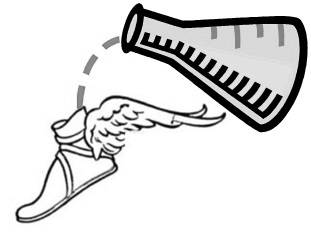I'm probably gonna piss off a few people with this one. I can hear it now, “Um, John, you make a living by helping runners achieve their goals – including running marathons – you sure you wanna go there?”
Yep. I am going there.
Now don't get me wrong, there are all types of runners with all levels of goals and ambition and this post is not to make anyone feel badly about their commitment level. There's only so much time in a day, right? You're an amazing person in my mind for simply desiring to run a marathon.
But what's up with the 30 mile per week marathoner? Or, if you're a triathlete, the 5 training-hours-per-week marathoner? In my opinion, this is just nonsensical. You do know that you're training for a marathon, right?

If you have no intentions of improving as a marathon runner, then cool. Feel free to stop reading here.
I'm concerned about the person who wants to improve (or at least says they do). They seem to think that as long as they do the necessary long runs that they will run well. As if that's all it takes to run a good marathon!
Here are some of the one-liners I hear on a routine basis:
“I'm 4 weeks out from my race. Gotta get that 20 mile run in!”
“And this time, I'm gonna run three 20 milers! Maybe even a 22 miler!”
“I only ran three times this week – 5 on Tuesday and Friday was 6 miles. But Sunday I ran 18!”
Ever heard those phrases? You don't hear smart marathon runners uttering such nonsense. Here's why:
After you graduate from Marathon Finisher to Marathon Competitor, you have to train differently. In order to improve you can't simply modify your beginner program by running longer on the weekend. Weekend warriors belong at the recreation center!

To improve your marathon you must live a certain lifestyle. You must add mid-week miles and there's no getting around it.
As a recent Scottish study confirmed (though experienced runners and coaches have known this for a while), running more miles per week means more glycogen (sugar) depletion than running less miles per week. This is important because endurance improves through the repeated depletion of muscle glycogen stores in training.
A runner who runs 50 miles per week will have more glycogen depletion than the runner who runs 40 miles per week even if the 40 mi/wk runner does a 20 mile long run. Therefore, when I coach a marathoner, I usually try to talk them into running longer mid-week. For example, a 90 minute Wednesday or Thursday run will sufficiently raise your mileage and deplete that glycogen. Plus, you are completing your longest run of the week on tired legs – just like in the final miles of the race.
But beyond the performance benefits of increased weekly mileage, would you believe there are injury prevention benefits?
It's true. You are much less likely to get hurt if you run consistently high mileage than taking extended breaks between training blocks. In other words, by shutting it down and ramping it up, you are de-training significantly and then risk breaking down when you increase your training. Your body has to try to re-adapt to the stress of running every year. No wonder you keep getting hurt!!
Remember, high mileage is relative. Everyone is different and it's a process. It takes time to adapt to a higher mileage level. So take your time!

And so the problem, assuming you're motivated, is that you will need to devote more time to training. Therefore the question becomes, “how badly do you want to improve?” Do you really want to qualify for the Boston Marathon? Or do you just kinda want to? Do you really want to break 4 hours? 3 hours?
So the “ugly truth” is this:
How much of a priority is marathon improvement and are you willing to spend more of your valuable time training?
Running a marathon is an AWESOME experience and flying by depleted, cramping runners while crushing your PR is pretty cool, too. And at Boston it's even sweeter. In fact, it's probably the single greatest feeling I've ever had while running.
I'll get you there if you want. Fill out my contact form and let's get on with your success!
 Here’s the bottom line. Training smart trumps training stupid. Obviously. Yet, the biggest mistake made over and over again is training at the wrong pace given one’s current fitness.
Here’s the bottom line. Training smart trumps training stupid. Obviously. Yet, the biggest mistake made over and over again is training at the wrong pace given one’s current fitness.












